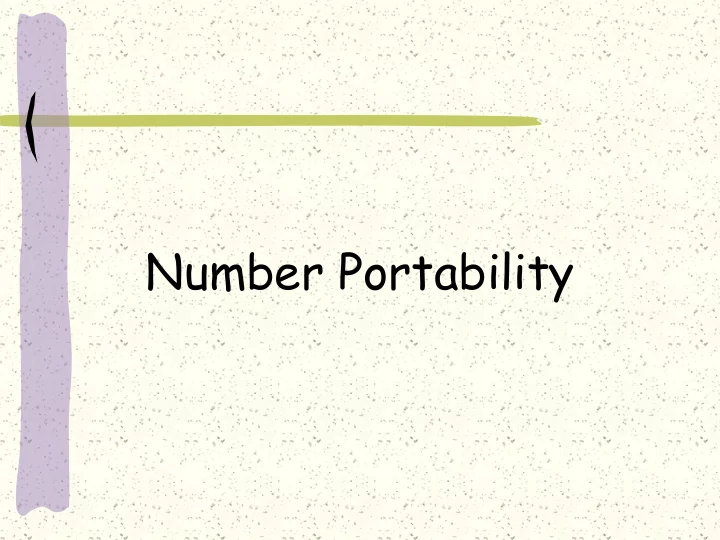

Number Portability
Three kinds of number portability Location portability: a subscriber may move from one location to another location without changing his or her telephone number Service portability: a subscriber may keep the same telephone number when changing the telecommunication services Operator portability: a subscriber may switch operators or service providers without changing his or her telephone number
Fig15.1 Number portability solutions for a fixed network
Call-forwarding Step1. The originating switch routes the call to the donor switch according to the dialed telephone number. In Figure 15.1(a), a solid arrow between two switches represents a trunk set up by using an SS7 ISUP Initial Address Message (IAM). Step2. If the dialed number has been ported, the donor switch forwards the call to the recipient switch. For a nonported number, the recipient switch is the donor switch in this step, and no forwarding action is performed.
Call Drop-back Step1. The originating switch queries the donor switch to obtain the routing information of the recipient switch. In Figure 15.1, dashed arrows represent SS7 TCAP signaling message exchange without involving trunk setup. Step2. The originating switch sets up the trunk to the recipient switch based on the obtained routing information.
Query-on-release (QoR) Step1. As in call forwarding, the originating switch sets up the trunk to the donor switch using an SS7 ISUP IAM message. If the dialed number has been ported, the donor switch replies with an SS7 ISUP Release Message (REL) with the QoR cause value. Step2. When the donor switch receives the REL message, the trunk to the donor switch is released. Since the QoR cause value indicates that the called party number is ported, the originating switch sends an SS7 TCAP message to query the number portability database for the routing address of the recipient switch.
Query-on-release (QoR) (2/2) Step3. The originating switch sets up the trunk to the recipient switch based on the obtained routing information.
All-call-query Step1. The originating switch sends an SS7 TCAP message to query the number portability database for the routing address of the recipient switch. Step2. The originating switch sets up the trunk to the recipient switch based on the obtained routing information.
Number portability for mobile networks When a mobile user switches operators and when mobile number portability is introduced, the mobile user keeps the MSISDN while being issued a new IMSI. The impact of number portability on mobile network: Location update: the assignment of a new IMSI is not affected by the introduction of number portability Mobile call origination: to originate a call to a ported number, the MSC needs to be equipped with a routing mechanism Mobile call termination: to deliver or terminate a call to a ported mobile number, the standard mobile call termination procedure is modified to accommodate the portability mechanism
Fig15.3 Simplified GSM call termination procedure and tromboning routing (dashed arrows: signaling; solid arrows: voice trunk Call termination to the MS must be routed to the GMSC at the home system due to: The provision of special features and service, and billing The capability to query the HLR database
Fig15.4 Signaling relay approach 1 (dashed arrows: signaling; solid arrows: voice trunk)
Signaling relay approach 1 Step1. The originating switch routes the incoming call to the donor GMSC of the ported MS. Step2. The donor GMSC sends the MSRN query message to the SRF. Steps3-5. The SRF determines the HLR of the destination MS. IF the MS is not ported, the original HLR is queried. IF the MS is ported, the recipient HLR is queried. Step6. Upon receipt of the MSRN, the donor GMSC routes the call to the serving MSC.
Fig15.5 Signaling relay approach 2 (dashed arrows: signaling; solid arrows: voice trunk)
Signaling relay approach 2 (1/2) Step1. The originating switch routes the incoming call to the donor GMSC of the ported MS. Step2. The donor GMSC sends the MSRN query message to the signaling relay function (SRF). Steps3-5. If the MS is ported, then the SRF queries the recipient HLR. In this case, the recipient HLR returns an intermediate routing number (IRN) instead of the MSRN. In the UK, the IRN consists of the called party number with a prefix that indicates the recipient GMSC.
Signaling relay approach 2 (2/2) Step6. Upon receipt of the IRN, the donor GMSC routes the call to the recipient GMSC. Steps7-9. The recipient GMSC routes the call using the standard GSM call termination procedure.
Fig15.6 Tromboning trunk setup in SRF 2 (dashed arrows: signaling; solid arrows: voice trunk)
Fig15.7 All-call-query approach 1 (dashed arrows: signaling; solid arrows: voice trunk)
All-call-query approach 1 Step1 and 2. The originating switch queries the mobile number portability database to obtain the IRN of the recipient GMSC. Step3. The originating switch sets up the trunk to the recipient GMSC. Steps4-6. The recipient GMSC routes the call according to the standard GSM call termination procedure.
Fig15.8 All-call-query approach 2 (dashed arrows: signaling; solid arrows: voice trunk)
All-call-query approach 2 Step1. The originating switch queries the mobile number portability database. Steps2-4. The number portability database utilizes the signaling relay function to identify the HLR of the called MS, and launches a query message to the recipient HLR to obtain the MSRN. Step5. The originating switch sets up the trunk to the serving MSC based on the IMSI.
Recommend
More recommend